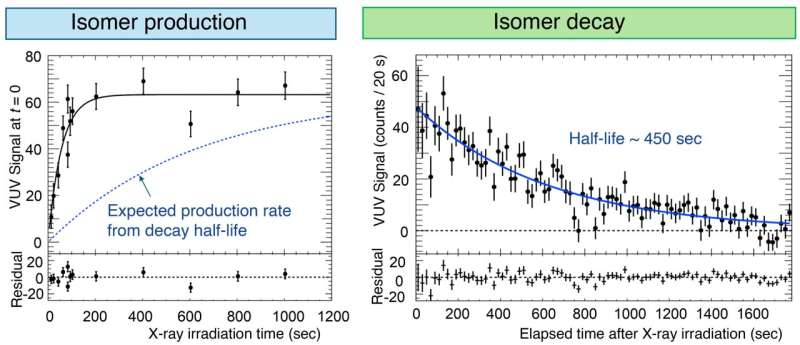Scientists use atomic clocks to measure the “second,” the smallest standard unit of time, with great precision. These clocks use natural oscillations of electrons in atoms, similar to how pendulums work in old grandfather clocks. The quest for an even more precise timekeeper led to the discovery of nuclear clocks, which use the transitions of atomic nuclei instead of electrons to keep time.
A rising contender for the development of ultra-precise nuclear optical clocks is the nuclear first-excited state of 229Th isotope. Its long half-life of 103 seconds and low excitation energy of a few electron volts make it ideal for excitation by vacuum ultraviolet (VUV) lasers, providing a precise reference transition for nuclear clocks.
Nuclear clocks can also be used in compact solid-state metrology devices and fundamental physics research. To explore the potential application of 229Th isomer, it is essential to understand its fundamental properties like isomeric energy, half-life, and the dynamics of excitation and decay in detail.
Working in this direction, Assistant Professor Takahiro Hiraki from Okayama University, Japan and his team including Akihiro Yoshimi and Koji Yoshimura have developed an experimental setup to effectively assess the population of the 229Th isomeric state and detect its radiative decay.
In their study published in Nature Communications on 16 July 2024, they synthesized 229Th-doped VUV transparent CaF2 crystals and demonstrated their ability to control 229Th isomeric state population using X-rays.
“Our group is working on fundamental physics using atoms and lasers. To realize a solid-state nuclear clock using 229Th, it is necessary to control the excitation and de-excitation state of the nucleus. In this study, we successfully controlled the nuclear states using X-rays, bringing us one step closer to building a nuclear clock,” stated Assistant Professor Hiraki while explaining the motivation behind their study.
To investigate the radiative decay (de-excitation), the team created excitation from the ground state of 229Th nucleus to an isomer state, via the second excited state, using a resonant X-ray beam. They found that the doped 229Th nucleus underwent radiative decay back to the ground state, along with the emission of a VUV photon.
One of the key findings was the rapid decay of the isomer state when exposed to X-ray beam irradiation and the “X-ray quenching” effect, which allowed de-population of the isomer on demand. The researchers believe that this controlled quenching could advance nuclear clock development, alongside other potential applications, such as portable gravity sensors and higher precision GPS systems.
Emphasizing the potential of nuclear optical clocks, Assistant Professor Hiraki says, “When the nuclear clock under development is completed, it will enable us to test whether ‘physical constants,’ especially fine structure constants, which were previously believed to remain unchanged, might vary over time. If time variation of physical constants is observed, it may lead to the elucidation of dark energy, one of the greatest mysteries of the universe.”
More information:
Takahiro Hiraki et al, Controlling 229Th isomeric state population in a VUV transparent crystal, Nature Communications (2024). DOI: 10.1038/s41467-024-49631-0
Provided by
Okayama University
Citation:
Findings from experimental setup demonstrate potential for compact and portable nuclear clocks (2024, September 13)
retrieved 14 September 2024
from https://phys.org/news/2024-09-experimental-setup-potential-compact-portable.html
This document is subject to copyright. Apart from any fair dealing for the purpose of private study or research, no
part may be reproduced without the written permission. The content is provided for information purposes only.

